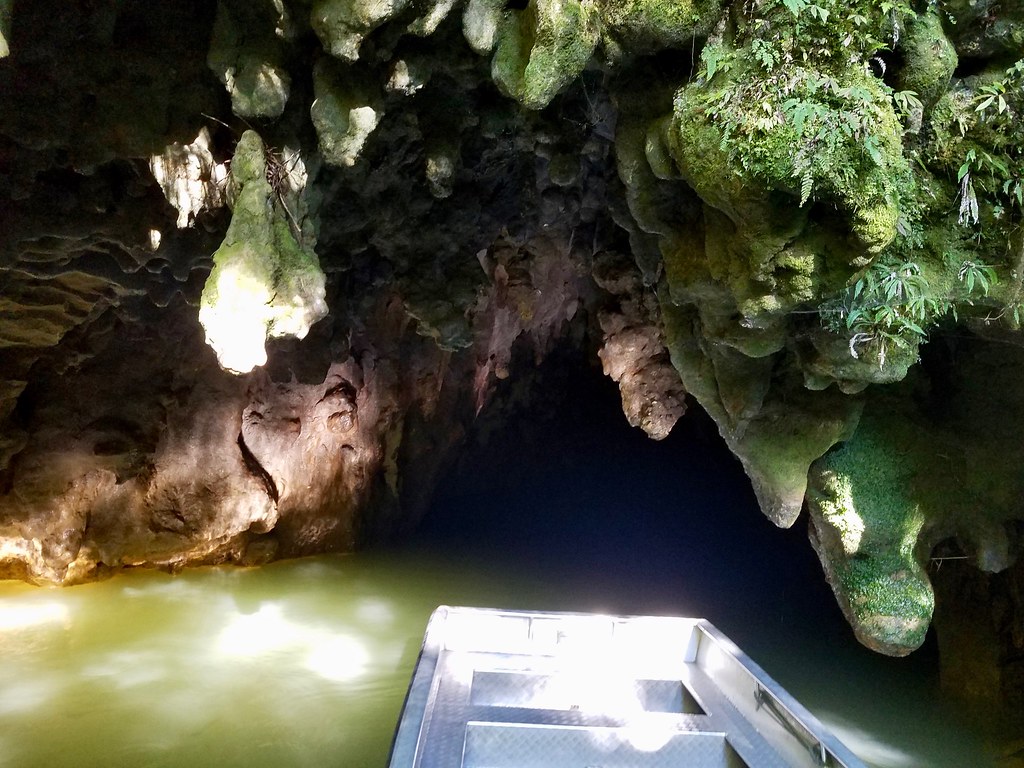As mentioned earlier, we didn’t spend much time away from the coastline during our adventures except for a couple of days on New Zealand’s North Island. I already wrote about the geothermal sites. We saw several additional noteworthy sites during our inland jaunt as well.
Hobbiton

My older son watched the entire Lord of the Rings trilogy during the extended airplane ride from the United States to New Zealand. My younger son and I did something similar before we left home, reacquainting ourselves with the Hobbit movies. We wanted to prepare ourselves. That entire series of movies used New Zealand as a scenic backdrop. Magnificent filming locations — displayed to the world through popular movies — became big tourist attractions as a result. Most of those sweeping panoramas and mountainous views in the movies occurred on the South Island. Fewer options existed on the North Island where we concentrated our efforts.
We discovered one shining exception: Hobbiton. Scenes from the movies often featured Hobbiton during times of peace, a springboard to beginning or returning from epic quests. Hobbits lived in bucolic bliss, tending their farms and villages amidst lush, rolling hills. They built their homes into the hillsides, some fancier than others, and went about their lives.
The movies needed a believable recreation of fictional Hobbiton and a farm near Matamata (map) seemed to meet the necessary criteria. The farmer who owned the land turned this movie set into a tourist attraction after filming ended.
Our visit took place on an exceptionally bright, sunny day. Hobbiton bustled with sightseers even in the middle of the week during the depths of winter. I couldn’t imagine how many tours must run through there during summer. Anyone expecting large rooms behind those round doors might be disappointed though. The space allowed doors to swing open and little more. Even a hobbit would feel cramped. These façades appeared only in outdoor scenes. The movies’ interior shots took place on a sound stage elsewhere.
Rotorua

I mentioned Rotorua extensively in the previous article. I don’t really need to say anything more except to confirm that it served as an excellent base for exploring a good swath of the North Island’s interior. It became a convenient midpoint to see a lot of places.
I’ll go ahead and include another photograph anyway. How about the Rotorua Lakes Water Aerodrome? I’ve always been fascinated by seaplanes (even flew in one in Alaska a few years ago). Anyway, moving along.
Maori Culture

I also mentioned Te Puia in that previously referenced geothermal article. While Te Puia got a lot of attention for its geological wonders, it also promoted an important cultural mission. Maori people owned and operated the site, and used it as a means to preserve and showcase their culture. The co-located New Zealand Maori Arts and Crafts Institute fascinated me the most. Young artisans honed their skills under the tutelage of experts, focusing on carving, sculpting, drawing, and weaving. Visitors could watch as skills passed from one generation to the next by walking down viewing corridors between classrooms.
There were other cultural items to explore there too (map). This included an elaborate “marae” — a central gathering place built in the unmistakable traditional style, dominated by a central meeting house. Our visit didn’t include the performing arts part of the tour although we did see a group being led into the meeting house in an elaborate welcoming ceremony. We also got to see a recreation of a village, a waka (an elaborately carved war canoe), and a couple of kiwis (the birds).
It was all much more than I expected, a pleasant surprise, considering our original purpose was to see the geysers.
Waitomo Glowworm Caves

Limestone caves formed over millennia on the western uplands of the North Island, an area known as the King Country. The slow dripping of water near Waitomo created a massive system of caverns there. We could have selected any number of caves to visit that included a multitude of different activities. The most interesting one for us seemed to be the Glowworm Caves located just outside of Waitomo Caves Village (map).
The tour began as they typically do, with a walk past a series of vaulted chambers of stalactites and related formations, plus the usual turning off of the lights so everyone could experience total darkness. Then it transitioned to something entirely more unique, a completely silent boat ride through darkness beneath a colony of glowworms. Noise apparently annoyed glowworms who would then turn off their lights, so everyone kept quiet. It felt like sitting outside on the darkest, clearest evening beneath a million tiny stars. I’d never experienced anything quite like it before.
The bioluminescence came from the larvae of a certain type of gnat, Arachnocampa luminosa found only in New Zealand. They tended to congregate in dark, protected places like caves. What appeared beautiful in the dark didn’t necessarily translate the same way with the lights on. Each glowworm dangled a sticky mucus tendril several centimetres below its body to capture prey. The light attracted poor unsuspecting insects into the trap. Then a glowworm simply slurped up the mucus to retrieve its feast. Our boys liked the glowworms’ alternate name, Snot Maggots. I tried to put those thoughts aside as I appreciated the lightshow while we floated under the stars.
Articles in the Australasian Adventures Series:
- Preparations and Arrival
- On the Waterfront
- Vistas
- Geothermal
- Heading Inland
- The Hunter Region
- Wild Animal Encounters
- Captive Animal Encounters
- Epic Runs
- Breweries
- Lists
- Changes
See Also: The Complete Photo Album on Flickr

Leave a Reply